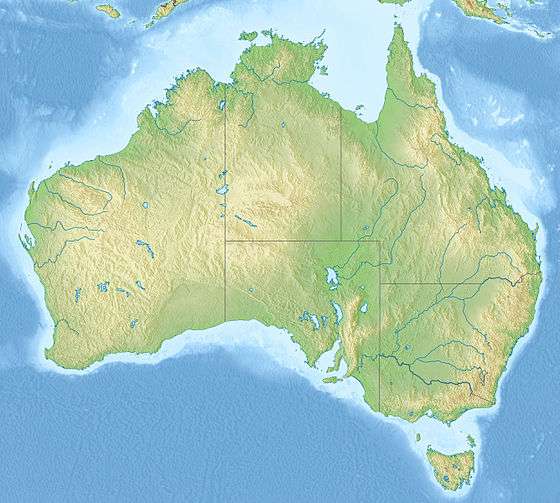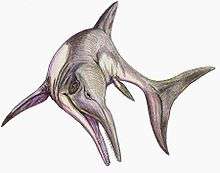Bulldog Shale
The Bulldog Shale is a formation of Early Cretaceous age (Aptian to Albian stages) that forms part of the Marree Subgroup of the Rolling Downs Group, located in the Eromanga Basin of South Australia, Queensland and New South Wales.[1][2]
| Bulldog Shale Stratigraphic range: Aptian-Albian ~120–110 Ma | |
|---|---|
| Type | Geological formation |
| Unit of | Rolling Downs Group Marree Subgroup |
| Sub-units | Wilpoorinna Breccia Member |
| Underlies | Coorikiana Sandstone |
| Overlies | Cadna-owie Formation |
| Thickness | 200–340 m (660–1,120 ft) |
| Lithology | |
| Primary | Mudstone, claystone |
| Other | Shale, limestone, gypsum |
| Location | |
| Coordinates | 30.5°S 137.2°E |
| Approximate paleocoordinates | 67.5°S 104.5°E |
| Region | |
| Country | |
| Extent | Eromanga Basin |
 Bulldog Shale (Australia)  Bulldog Shale (South Australia) | |
Description
It is the lowermost unit in the Marree Subgroup, overlying the Cadna-owie Formation and is overlain by the Coorikiana Sandstone. The formation dates to the Aptian to Albian stages of the Early Cretaceous.[3] The Bulldog Shale is composed of finely laminated carbonaceous and pyritic mudstone and claystone beds. Weathering has caused heavy leaching and bleaching in some regions of the Bulldog Shale, including those around Coober Pedy, so that the rocks are white or multicolored. These horizons contain rich opal deposits. Horizons without this bleaching are primarily composed of organic-rich shale. Gypsum, in addition to carbonate limestone concretions rich in fossils are common in these unbleached shaly horizons.[4]
Fossil content
The Bulldog Shale has yielded fossils of plants, invertebrates, fish, and reptiles.[5] The macroinvertebrate fauna of this formation includes several molluscs, such belemnites, gastropods, and bivalves. Fish are represented by chimaeras[6] and ray-finned fish (these include teleosts)[6] and a lungfish. Sharks are conspicuously absent in the Bulldog Shale.[4] Many plesiosaurs are known from the formation, including leptocleidids, elasmosaurids,[4] pliosaurids, and possible polycotylids. Ichthyosaurs are also present.[7] Archosaur fossils from the Bulldog Shale are rare, and are represented mostly indeterminate specimens, some of which can be assigned to Dinosauria.[8] Due to the coastal location of the Bulldog Shale, large amounts of wood have also been recovered in this formation.[4]
Paleobiota
Archosaurs
| Archosaurs reported from the Bulldog Shale | |||||
|---|---|---|---|---|---|
| Genus | Species | Location | Material | Notes | Images |
| Archosauria | Indet. | Andamooka, Coober Pedy | Various fragments, some opalized | Includes some material referable to Dinosauria[8] | |
| Kakuru | K. kujani | Andamooka | Opalized tibia | Now considered Tetanurae indet.[8] | |
Plesiosaurs
| Plesiosaurs reported from the Bulldog Shale | |||||
|---|---|---|---|---|---|
| Genus | Species | Location | Material | Notes | Images |
| Kronosaurus | K. queenslandicus | Teeth | Originally referred to cf. K. sp.[4][7] |  | |
| Leptocleidus | L. sp. | Reclassified as Umoonasaurus[7] | |||
| Opallionectes | O. andamookaensis | Lunatic Hill opal field | Opalized incomplete articulated skeleton | A plesiosaur of uncertain classification[4][7] | |
| Umoonasaurus | U. demoscyllus | Zorba Extension Opal Field, Andamooka opal fields, Curdimurka area, Neales River region | Opalized skulls and skeletons | A small leptocleidid[9] plesiosaur with three crests on its head[2] |  |
| Elasmosauridae | Indet. | Andamooka | Partial skeletons and several fragments | [4] | |
| Polycotylidae | Indet. | Hermit Hill | Fragmentary specimen | [4] | |
Ichthyosaurs
| Ichthyosaurs reported from the Bulldog Shale | |||||
|---|---|---|---|---|---|
| Genus | Species | Location | Material | Notes | Images |
| Platypterygius | P. sp. | Bopeechee Siding | Fragmentary cranial and postcranial material | The specimen SAM P14508 shows evidence of healed bite marks.[5] |  |
Chondrichthyes
| Chondrichthyans reported from the Bulldog Shale | |||||
|---|---|---|---|---|---|
| Genus | Species | Location | Material | Notes | Images |
| Edaphodon | E. eyrensis | ||||
Color key
|
Notes Uncertain or tentative taxa are in small text; |
See also
- Fossiliferous stratigraphic units in Australia
- Toolebuc Formation, Albian fossiliferous formation of the northern Eromanga Basin
- Wallumbilla Formation, contemporaneous fossiliferous formation of the northern Eromanga Basin
- Bungil Formation, Valanginian to Aptian fossiliferous formation of the Surat Basin
- Eumeralla Formation, contemporaneous fossiliferous formation of the Otway Basin
- Wonthaggi Formation, Valanginian to Aptian fossiliferous formation of the Gippsland Basin
- Aptian formations
- Crato Formation, contemporaneous Lagerstätte of northeastern Brazl
- Elrhaz Formation, contemporaneous fossiliferous formation of Niger
- Jiufotang Formation, contemporaneous fossiliferous formation of northeastern China
- Paja Formation, contemporaneous Lagerstätte of central Colombia
- Tookoonooka crater
References
- Geoscience Australia. "Stratigraphic Unit Details: Bulldog Shale". Australian Stratigraphic Units Database. Retrieved 26 June 2020.
- Kear, Benjamin P; Schroeder, Natalie I.; Lee, Michael S.Y. (2006). "An archaic crested plesiosaur in opal from the Lower Cretaceous high-latitude deposits of Australia". Biology Letters. 2 (4): 615–619. doi:10.1098/rsbl.2006.0504. PMC 1833998. PMID 17148303.
- Bulldog Shale at Fossilworks.org
- Kear, Benjamin P. (2006). "Marine reptiles from the Lower Cretaceous of South Australia: elements of a high‐latitude cold‐water assemblage". Palaeontology. 49 (4): 837–856.
- Zammit, Maria; Kear, Benjamin P. (2011). "Healed bite marks on a Cretaceous ichthyosaur" (PDF). Acta Palaeontologica Polonica. 56 (4): 859–863. doi:10.4202/app.2010.0117.
- McHenry, Colin R. (2009). Devourer of Gods: The palaeoecology of the Cretaceous pliosaur Kronosaurus queenslandicus (Thesis). The University of Newcastle.
- Kear, Benjamin P. (2016). "Cretaceous marine amniotes of Australia: perspectives on a decade of new research" (PDF). Memoirs of Museum Victoria. 74: 17–28. doi:10.24199/j.mmv.2016.74.03.
- Barrett, Paul M.; Kear, Benjamin P.; Benson, Roger B.J. (2010). "Opalized archosaur remains from the Bulldog Shale (Aptian: Lower Cretaceous) of South Australia" (PDF). Alcheringa. 34: 1–9. ISSN 0311-5518.
- Parrilla-Bel, Jara; Canudo, José Ignacio (2015). "On the presence of plesiosaurs in the Blesa Formation (Barremian) in Teruel (Spain)". Neues Jahrbuch für Geologie und Paläontologie, Abhandlungen. 278 (2): 213–227. doi:10.1127/njgpa/2015/0526.
Further reading
- B. P. Kear. 2007. A juvenile pliosauroid plesiosaur (Reptilia: Sauropterygia) from the Lower Cretaceous of South Australia. Journal of Paleontology 81(1):154-162
- R. E. Molnar. 1991. Fossil reptiles in Australia. In P. Vickers-Rich, J. M. Monaghan, R. F. Baird, & T. H. Rich (eds.), Vertebrate Paleontology of Australasia 605-702
- R. E. Molnar. 1980. Australian late Mesozoic continental tetrapods: some implications. Mémoires de la Société Géologique de France, Nouvelle Série 139:131-143